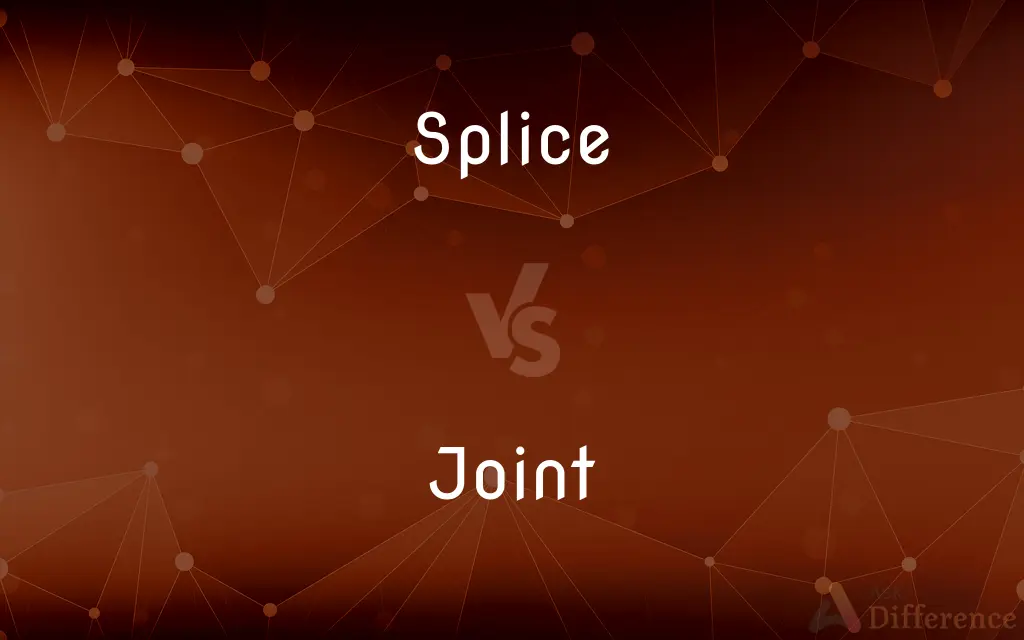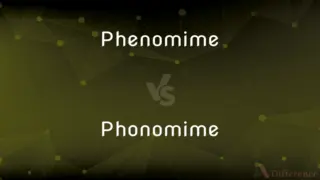Splice vs. Joint — What's the Difference?
By Urooj Arif & Maham Liaqat — Updated on March 29, 2024
A splice is a method of connecting two pieces of material to extend their length, focusing on continuity, while a joint refers broadly to the connection between two or more parts, emphasizing the point of contact and its method.

Difference Between Splice and Joint
Table of Contents
ADVERTISEMENT
Key Differences
A splice specifically aims to extend the length of materials such as wires, fibers, or ropes by connecting their ends together, ensuring continuity and maintaining the strength or functionality of the material. This method is particularly important in fields like electrical wiring, telecommunications, and construction, where the integrity of the connection can significantly impact overall performance and safety. On the other hand, a joint encompasses a wider variety of connections between materials or components, not limited to extending length but also including assembly, movement, and functionality. Joints can be found in numerous applications, from construction (wood or metal joints) to biology , and are designed based on the requirements of strength, flexibility, and durability.
The technique of splicing often requires specific tools and methods, such as soldering for electrical wires or weaving for ropes, to ensure that the splice can bear loads and stresses similar to the original material. In contrast, joints might be created using a range of methods including welding, soldering, fastening (with screws, nails, or bolts), or even adhesion, depending on the materials involved and the purpose of the joint.
Splices are evaluated based on criteria like electrical conductivity, tensile strength, and minimal disruption to the original material's functionality. Conversely, the evaluation of a joint focuses on its ability to fulfill its intended function, which could include load-bearing capacity, flexibility, or the ability to be disassembled and reassembled.
While splices are often intended to be as inconspicuous or seamless as possible to maintain the integrity and appearance of the material, joints can be both functional and decorative, contributing to the aesthetic or design of a structure or item. The design considerations for a joint include not only its functional aspects but also how it fits into the overall structure or design of the assembled item.
Splicing and jointing are both critical in various fields for different purposes: splicing for extending and maintaining continuity in materials, and jointing for assembling and providing functionality to structures and systems.
ADVERTISEMENT
Comparison Chart
Definition
Connection method to extend the length of materials.
Connection point between two or more parts or materials.
Purpose
To ensure continuity and maintain strength.
To assemble, provide movement, or functionality.
Applications
Electrical wiring, ropes, telecommunications.
Construction, machinery, biology, furniture.
Technique
Soldering, weaving, fusing.
Welding, fastening, soldering, adhering.
Evaluation
Electrical conductivity, tensile strength.
Load-bearing capacity, flexibility, aesthetics.
Design Goal
Inconspicuous, maintaining original functionality.
Functional and/or decorative, part of overall design.
Materials
Wires, fibers, ropes.
Wood, metal, plastics, biological tissues.
Compare with Definitions
Splice
Connecting two pieces of rope using a knot.
The sailors used a splice to join the ropes and extend the towline.
Joint
The connection between two pieces of wood using dovetail joints.
The carpenter crafted a joint to assemble the drawer seamlessly.
Splice
Fusing fiber optic cables for telecommunications.
Technicians splice fiber optic cables to ensure seamless data transmission.
Joint
Welding two metal plates at a construction site.
The weld joint strengthened the framework of the building.
Splice
Joining two electrical wires to extend a circuit.
The electrician created a splice to extend the wiring to the new outlet.
Joint
A pivot point in machinery for movement.
The robot's arm was equipped with joints for precise movement.
Splice
Integrating additional yarn in a textile process.
The weaver spliced new yarn to continue the fabric without interruption.
Joint
A human knee, as an example of a biological joint.
The knee joint allows for a wide range of motion and flexibility.
Splice
Extending a metal rod by welding its ends to another rod.
The construction workers spliced the metal rods to reinforce the structure.
Joint
The adhesive bonding of plastic components in a product.
The manufacturer used a strong joint to assemble the toy parts.
Splice
To join (two pieces of film, for example) at the ends.
Joint
A joint or articulation (or articular surface) is the connection made between bones in the body which link the skeletal system into a functional whole. They are constructed to allow for different degrees and types of movement.
Splice
To join (ropes, for example) by interweaving strands.
Joint
A place or part at which two or more things are joined.
Splice
To join (pieces of wood) by overlapping and binding at the ends.
Joint
A way in which two or more things are joined
A mortise-and-tenon joint.
Splice
To join together or insert (segments of DNA or RNA) so as to form new genetic combinations or alter a genetic structure.
Joint
A point of articulation between two or more bones, especially such a connection that allows motion.
Splice
(Slang) To join in marriage
They went to Las Vegas to get spliced.
Joint
A point in the exoskeleton of an invertebrate at which movable parts join, as along the leg of an arthropod.
Splice
A joining by splicing.
Joint
(Botany) An articulation on a fruit or stem, such as the node of a grass stem.
Splice
A place where parts have been spliced.
Joint
(Geology) A fracture or crack in a rock mass along which no appreciable movement has occurred.
Splice
(nautical) A junction or joining of ropes made by splicing them together.
Joint
A large cut of meat for roasting.
Splice
(electrical) The electrical and mechanical connection between two pieces of wire or cable.
Joint
A cheap or disreputable gathering place
"The tavern is ... just a joint with Formica tables, a vinyl floor, lights over the mirrors" (Scott Turow).
Splice
(cricket) That part of a bat where the handle joins the blade.
Joint
A building or dwelling.
Splice
Bonding or joining of overlapping materials.
Joint
A prison. Often used with the.
Splice
(genetics) The process of removing intron sequences from the pre-messenger RNA, and then joining together exons.
Joint
(Slang) A marijuana cigarette.
Splice
To unite, as two ropes, or parts of a rope, by a particular manner of interweaving the strands, the union being between two ends, or between an end and the body of a rope.
Joint
Vulgar Slang A penis.
Splice
To unite, as spars, timbers, rails, etc., by lapping the two ends together, or by applying a piece which laps upon the two ends, and then binding, or in any way making fast.
Joint
Shared by or common to two or more
Our joint presence.
A joint income-tax return.
Splice
(slang) To unite in marriage.
Joint
Sharing with another or others
A joint tenant.
Splice
(figuratively) To unite as if splicing.
He argues against attempts to splice different genres or species of literature into a single composition.
Joint
Formed or characterized by cooperation or united action
Joint military maneuvers.
Splice
(genetics) To remove intron sequences from the pre-messenger RNA, and then join together exons.
Joint
Involving both houses of a legislature
A joint session of Congress.
Splice
To unite, as two ropes, or parts of a rope, by a particular manner of interweaving the strands, - the union being between two ends, or between an end and the body of a rope.
Joint
(Law) Regarded as one, especially with regard to tort liability or interest in property.
Splice
To unite, as spars, timbers, rails, etc., by lapping the two ends together, or by applying a piece which laps upon the two ends, and then binding, or in any way making fast.
Joint
(Mathematics) Involving two or more variables.
Splice
To unite in marriage.
Joint
To combine or attach with a joint or joints
Securely jointed the sides of the drawer.
Splice
A junction or joining made by splicing.
Joint
To provide or construct with joints
Joint a boom on a crane.
Splice
A junction where two things (as paper or film or magnetic tape) have been joined together;
The break was due to an imperfect splice
Joint
To separate (meat) at the joints.
Splice
Joint made by overlapping two ends and joining them together
Joint
Done by two or more people or organisations working together.
The play was a joint production between the two companies.
Splice
Join the ends of;
Splice film
Joint
The point where two components of a structure join, but are still able to rotate.
This rod is free to swing at the joint with the platform.
Splice
Perform a marriage ceremony;
The minister married us on Saturday
We were wed the following week
The couple got spliced on Hawaii
Joint
The point where two components of a structure join rigidly.
The water is leaking out of the joint between the two pipes.
Splice
Join together so as to form new genetic combinations;
Splice genes
Joint
(anatomy) Any part of the body where two bones join, in most cases allowing that part of the body to be bent or straightened.
Splice
Join by interweaving strands;
Splice the wires
Joint
The means of securing together the meeting surfaces of components of a structure.
The dovetail joint, while more difficult to make, is also quite strong.
Joint
A cut of meat, especially (but not necessarily) (a) one containing a joint in the sense of an articulation or (b) one rolled up and tied.
Set the joint in a roasting tin and roast for the calculated cooking time.
Joint
The part or space included between two joints, knots, nodes, or articulations.
A joint of cane or of a grass stem; a joint of the leg
Joint
(geology) A fracture in which the strata are not offset; a geologic joint.
Joint
A place of business, particularly in the food service or hospitality industries.
It was the kind of joint you wouldn't want your boss to see you in.
Joint
A place of resort for tramps.
Joint
An opium den.
Joint
Prison.
I'm just trying to stay out of the joint.
Joint
(slang) A marijuana cigarette.
After locking the door and closing the shades, they lit the joint.
Joint
A syringe used to inject an illicit drug.
Joint
The penis.
Joint
Sense}} A thing.
A Spike Lee joint
Joint
(transitive) To unite by a joint or joints; to fit together; to prepare so as to fit together
To joint boards
A jointing plane
Joint
(transitive) To join; to connect; to unite; to combine.
Joint
(transitive) To provide with a joint or joints; to articulate.
Joint
(transitive) To separate the joints; of; to divide at the joint or joints; to disjoint; to cut up into joints, as meat.
Joint
(intransitive) To fit as if by joints; to coalesce as joints do.
The stones joint, neatly.
Joint
The place or part where two things or parts are joined or united; the union of two or more smooth or even surfaces admitting of a close-fitting or junction; junction; as, a joint between two pieces of timber; a joint in a pipe.
Joint
A joining of two things or parts so as to admit of motion; an articulation, whether movable or not; a hinge; as, the knee joint; a node or joint of a stem; a ball and socket joint. See Articulation.
A scaly gauntlet now, with joints of steel,Must glove this hand.
To tear thee joint by joint.
Joint
The part or space included between two joints, knots, nodes, or articulations; as, a joint of cane or of a grass stem; a joint of the leg.
Joint
Any one of the large pieces of meat, as cut into portions by the butcher for roasting.
Joint
A plane of fracture, or divisional plane, of a rock transverse to the stratification.
Joint
The space between the adjacent surfaces of two bodies joined and held together, as by means of cement, mortar, etc.; as, a thin joint.
Joint
The means whereby the meeting surfaces of pieces in a structure are secured together.
Joint
A projecting or retreating part in something; any irregularity of line or surface, as in a wall.
Joint
A narrow piece of scenery used to join together two flats or wings of an interior setting.
Joint
A disreputable establishment, or a place of low resort, as for smoking opium; - also used for a commercial establishment, implying a less than impeccable reputation, but often in jest; as, talking about a high-class joint is an oxymoron.
Joint
A marijuana cigarette.
Joint
Prison; - used with "the".
Joint
Joined; united; combined; concerted; as, joint action.
Joint
Involving the united activity of two or more; done or produced by two or more working together.
I read this joint effusion twice over.
Joint
United, joined, or sharing with another or with others; not solitary in interest or action; holding in common with an associate, or with associates; acting together; as, joint heir; joint creditor; a joint bank account; joint debtor, etc.
Joint
Shared by, or affecting two or more; held in common; as, joint property; a joint bond.
A joint burden laid upon us all.
Joint
To unite by a joint or joints; to fit together; to prepare so as to fit together; as, to joint boards.
Pierced through the yielding planks of jointed wood.
Joint
To join; to connect; to unite; to combine.
Jointing their force 'gainst Cæsar.
Joint
To provide with a joint or joints; to articulate.
The fingers are jointed together for motion.
Joint
To separate the joints; of; to divide at the joint or joints; to disjoint; to cut up into joints, as meat.
Quartering, jointing, seething, and roasting.
Joint
To fit as if by joints; to coalesce as joints do; as, the stones joint, neatly.
Joint
(anatomy) the point of connection between two bones or elements of a skeleton (especially if the articulation allows motion)
Joint
A disreputable place of entertainment
Joint
The shape or manner in which things come together and a connection is made
Joint
A piece of meat roasted or for roasting and of a size for slicing into more than one portion
Joint
Junction by which parts or objects are joined together
Joint
Marijuana leaves rolled into a cigarette for smoking
Joint
Fit as if by joints;
The boards fit neatly
Joint
Provide with a joint;
The carpenter jointed two pieces of wood
Joint
Fasten with a joint
Joint
Separate (meat) at the joint
Joint
United or combined;
A joint session of Congress
Joint owners
Joint
Affecting or involving two or more;
Joint income-tax return
Joint ownership
Joint
Involving both houses of a legislature;
A joint session of Congress
Common Curiosities
What is a joint?
A joint refers to the connection between two or more parts or materials, which may serve various purposes such as assembly, movement, or providing structural integrity.
What are common techniques for making a splice?
Common splicing techniques include soldering, weaving, and fusing, depending on the material being joined.
How do splices and joints differ in application?
Splices are primarily used for extending materials like wires or ropes, while joints have a broader range of applications including construction, machinery, and even in biological systems.
What is a splice?
A splice is a method used to connect two pieces of material, aiming to extend their length while maintaining or enhancing their strength and functionality.
What types of joints are there?
There are many types of joints, including fixed joints (like welded joints in metal), movable joints (like hinges or ball joints in machinery), and biological joints (like human elbows and knees).
Why are joints important in construction?
Joints in construction are crucial for assembling materials, providing structural integrity, and allowing for necessary movement within buildings and other structures.
Are all joints meant to be permanent?
Not all joints are permanent; some, like bolted or adhesive joints, can be designed for disassembly or adjustment.
What materials can be spliced?
Materials that can be spliced include electrical wires, fiber optics, ropes, and some types of metal rods.
Can joints be decorative?
Yes, joints can be both functional and decorative, adding aesthetic value to furniture, jewelry, and architectural elements.
Can a splice affect the functionality of the material?
A properly made splice should maintain or even enhance the original functionality of the material, ensuring strength and continuity.
Is splicing common in telecommunications?
Yes, splicing is a common and crucial technique in telecommunications for connecting fiber optic cables.
How is the strength of a splice measured?
The strength of a splice is typically measured in terms of tensile strength and, in the case of electrical splices, also in electrical conductivity and resistance.
What factors influence the choice of joint type?
Factors include the materials being joined, the desired strength and flexibility, the need for disassembly, and aesthetic considerations.
Can a splice be considered a type of joint?
While a splice can be considered a specific type of joint focused on extending length, it is usually distinguished by its specific purpose and technique.
Share Your Discovery

Previous Comparison
Phenomime vs. Phonomime
Next Comparison
Idealistically vs. IdeallyAuthor Spotlight
Written by
Urooj ArifUrooj is a skilled content writer at Ask Difference, known for her exceptional ability to simplify complex topics into engaging and informative content. With a passion for research and a flair for clear, concise writing, she consistently delivers articles that resonate with our diverse audience.
Co-written by
Maham Liaqat













































